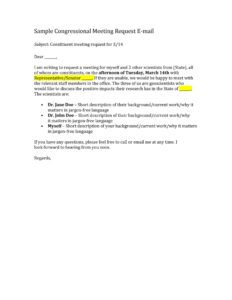Utilizing such a structure offers several advantages. It reduces ambiguity and back-and-forth communication, saving valuable time for all parties involved. A well-designed format also ensures consistency in requests, simplifying the process for recipients to assess and prioritize incoming meeting proposals. Ultimately, this contributes to a more organized and productive due diligence or deep dive process.
This article will further explore the key components of effective meeting requests in the context of pre-Initial Diligence preparation, offering practical guidance and examples to optimize communication and facilitate a successful outcome.
Key Components of a Pre-Initial Diligence Meeting Request
Effective pre-Initial Diligence meeting requests require specific information to ensure clarity and facilitate efficient scheduling. The following components contribute to a well-structured and informative request.
1. Subject Line: A concise and informative subject line allows recipients to quickly understand the request’s purpose. Specificity is crucial; for example, “Pre-ID Meeting Request: [Target Company Name] – [Area of Focus]” is preferable to a generic subject like “Meeting Request.”
2. Meeting Objective: A clear statement of the meeting’s purpose is essential. This ensures all participants understand the intended outcomes and can prepare accordingly.
3. Proposed Attendees: Listing proposed attendees from both requesting and receiving parties allows for efficient scheduling and ensures relevant individuals are included.
4. Date and Time Options: Providing multiple date and time options increases the likelihood of finding a slot that accommodates all participants’ schedules.
5. Meeting Duration: Estimating the meeting duration helps participants manage their time effectively and sets expectations for the discussion’s scope.
6. Preparation Materials (Optional): If pre-reading materials are required, including links or attachments within the request allows participants to familiarize themselves with the relevant information beforehand.
7. Contact Information: Including clear contact information facilitates communication and allows recipients to easily clarify any questions regarding the meeting request.
By incorporating these elements, requests become clear, comprehensive, and actionable, contributing to a more efficient and productive pre-Initial Diligence process. This structured approach minimizes scheduling conflicts and ensures all parties are adequately prepared, ultimately maximizing the value of these crucial preliminary discussions.
How to Create a Pre-Initial Diligence Meeting Request Template
Creating a standardized template for pre-Initial Diligence (ID) meeting requests promotes consistency, efficiency, and clarity throughout the due diligence process. The following steps outline a structured approach to developing such a template.
1. Define the Purpose: Begin by clearly articulating the template’s objective. This ensures the template serves its intended function within the broader due diligence workflow.
2. Establish Essential Fields: Incorporate fields for crucial information, such as the meeting subject, objective, proposed attendees, date and time options, estimated duration, and any required preparation materials. Consider optional fields for specific project codes or internal tracking numbers.
3. Design a Clear Layout: Structure the template logically to facilitate easy comprehension and completion. A clear and organized layout ensures all necessary information is readily accessible.
4. Incorporate Branding (Optional): Adding company branding can enhance professionalism and reinforce corporate identity.
5. Test and Refine: Pilot the template with relevant stakeholders and gather feedback. Iterative refinement based on user experience optimizes the template’s effectiveness.
6. Implement and Train: Once finalized, implement the template across relevant teams and provide training to ensure consistent usage and maximize its benefits.
7. Periodic Review: Regularly review the template’s effectiveness and make adjustments as needed to align with evolving business needs and best practices.
A well-designed template streamlines communication, reduces ambiguity, and contributes to a more efficient and effective pre-Initial Diligence process. Regular evaluation and adjustments ensure the template remains a valuable tool for managing communications and facilitating successful outcomes.
Standardized meeting request templates for pre-Initial Diligence communication promote efficiency and clarity. Key components such as a clear objective, proposed attendees, and multiple date/time options ensure effective scheduling and preparation. Creating a template involves defining its purpose, establishing essential fields, and iterative refinement based on user feedback. Consistent implementation and periodic review maintain the template’s efficacy in supporting a streamlined and productive due diligence process.
Effective communication is paramount to successful pre-Initial Diligence preparation. Adopting structured meeting request procedures, supported by well-designed templates, significantly contributes to a smoother, more efficient, and ultimately more successful due diligence undertaking. Investing time in refining these processes offers substantial returns in overall productivity and outcomes.

